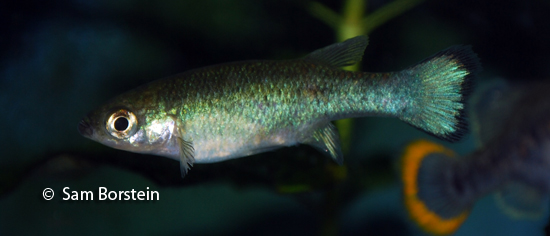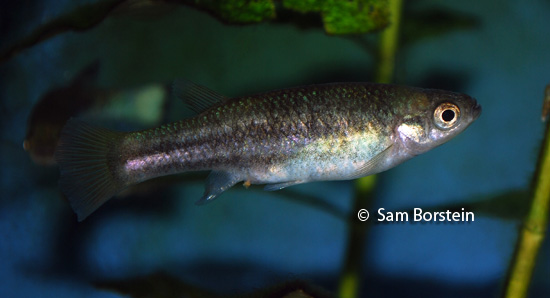Ataeniobius toweri
Meek, 1904
Bluetailed Goodeid



Above: A male Bluetail Goodeid. Photo by Sam Borstein.
Etymology:
Genus- A= privitive (Greek), taenia= band (Greek), bios= living (Greek), referring to the primitive embryo of this species.
Species- toweri= named after the discoverer Dr. W.L. Towers.
Intro:
The Blue Tail Goodeid is a critically endangered species of livebearer native to Mexico. These livebearers are not very beautiful, but make a very nice community fish. They also tell you when you need to do a water change. As Mike Schadle would say "They let me know pretty quickly if my weekly 50% water change is behind schedule". When the males lose the blue color in the fins, it is time to change the water.
This fish, typed by Meek in 1904 and named for Dr. W. L. Tower is considered a primitive livebearer due to the fry lacking a Trophotaenia at birth. This is why the genus Ataeniobus is monotypic. The fish overall is similar to the genus Goodea and don't be surprised if you see this species moved to that genus anytime soon.
Distribution:
Like all Goodeids, the Blue Tail Goodeid is from Mexico. While most are from cooler highland areas, the Blue Tail Goodeid prefers warmer waters as it is found in Laguna Media Luna, a drainage of the Rio Verde.
Size, Maturity, and Sexual Dimorphism:
Size: Males- 2.5 inches, Females- 2 inches
Maturity: 2 inches
Sexual Dimorphism: Females are larger. Males possess blue fins. Males also have a modified anal fin for reproduction called an andropodium. This can be seen as a notch in the anal fin.

Above: A female Blue Tail Goodeid. Photo by Sam Borstein.
Care:
Blue Tail Goodeids are easy to care for. They are peaceful, so they can be kept in a community tank with no issues. They also prefer warmer waters than other species from their genus, so you can keep them like any other tropical fish at 76-80 degrees.
Diet:
Blue Tail Goodeids are omnivorous and will eat anything in aquarium. You should feed them fibrous foods once in a while.
Breeding:
Blue Tail Goodeids breed like most livebearers. This species has a very long gestation period, a little over 1 month.
The fry are huge when born, and therefore in small number. The largest spawn I ever had was 9, but the fry are a little over 3/4 of an inch! The fry hang at the top of the tank for their first week out of the womb. fry are easy to raise on either baby brine shrimp or crushed flake and grow quickly.
Conclusion:
The Blue Tail Goodeid is an underappreciated fish in the hobby.It is a beautiful goodeid and is one my favorite livebearers.
References:
- Hubbs, C.L. & Turner, C.L. (1939) Studies of the fishes of the order Cyprinodontes. XVI. A revision off the Goodeidae. Miscellaneous Publications, Museum Of Zoology, University Of Michigan 42, 1-80.
- IUCN. IUCN Red List of Threatened Species. <http://www.iucnredlist.org>.
- Meek, S. E. (1904) The fresh water fishes of Mexico North of the Isthmus of Tehuantepec. Field Columbian Museum Publication, 93, 1-252.
- Miller, R.R., Minckley, W.L. & Norris, S.M. (2005) Freshwater Fishes of México. Museum of Zoology, University of Michigan, & University of Chicago Press, Chicago, 652 pp.
